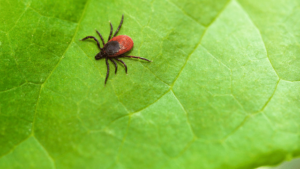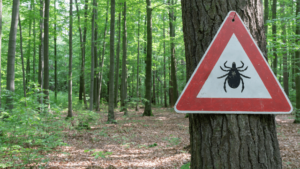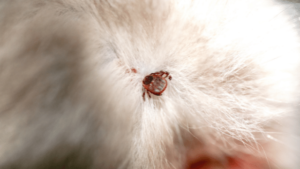- March 13, 2022
- By Mosquito Toronto
- Ticks
When the weather gets warm, people flock to the outdoors to soak up some much-needed sunshine, but humans aren’t the only ones looking to enjoy the change in season. Ticks in Toronto thrive in warm environments and can turn any great outdoor adventure into a dangerous endeavour if caution is not taken.

Before you head out the door, it is important to know what ticks are and how to keep yourself as safe as possible so that you can enjoy time outside to the fullest extent.
What Are Ticks?
Ticks in Toronto are a part of the arachnid family, so they are closely related to spiders. They are very small creatures, typically measuring 2 to 5 mm. Ticks are parasitic and feed on human and animal hosts. They climb onto hosts that pass by, find a warm place on the host, and insert a feeding tube into the host to begin feeding. It can be difficult to know a tick is on you because their saliva numbs the area they are feeding on.
Blacklegged Ticks or “dog” ticks, one of the common ticks in Toronto, can be dangerous because many ticks carry bacteria that cause Lyme disease. Symptoms of Lyme disease initially include a bullseye-looking rash around the bite, fever, chills, muscle aches, and fatigue. However, Lyme disease has many long-lasting symptoms as well including facial palsy, arthritis, heart palpitations, and brain inflammation among others (CDC).

Are There Ticks in Toronto?
Ticks live in moist and warm environments. They like wooded and grassy areas as most of their animal hosts live in those areas. Ticks in Toronto parks are common, so they may be present in your backyard. You are most likely to encounter ticks in the spring, summer, and fall seasons. Locations that you should be wary of include the following:
· Piles of wood
· Piles of leaves
· Branches that are low to the ground
· Wooded or bushy areas
· Tall grasses and grassy fields
· Walls that stay wet
· Areas with a lot of trees
· Conservation area
How Does the City of Toronto Monitor Tick Activity?
The City is concerned about Lyme disease in Toronto. The city of Toronto monitors tick activity through a method called “dragging.” This process involves dragging a net through areas that have been known to house black-legged ticks in the past. They then count the ticks collected on the net and test the ticks for the bacteria that causes Lyme disease, Borrelia burgdoferi. They also collect data from any ticks brought in by community members.
With this information, they create a map of Toronto that highlights tick-dense locations and identify places where ticks were found to have Lyme disease bacteria. The statistics for ticks in Toronto 2022 are not yet available, but to see the map and dragging results by year, visit this page on the city of Toronto website.
What are the Tick Hotspots in Toronto?
In Toronto, locations that have the highest tick population include Highland Creek Park, Colonel Danforth Park, Cedar Ridge Park, High Park, Morningside Park, Toronto Islands, and The Rouge Valley. The majority of these locations are in the northeastern part of Toronto, with small hotspots spread throughout the province.

Ticks in High Park
In 2019, two black-legged ticks were reported in High Park in Toronto, according to Toronto Public Health’s tick surveillance program. The bacterium that induces Lyme disease was found to be absent in both ticks in High Park.
Park users that are “tick savvy” and have knowledge about ticks and the dangers they pose can help keep you and your family safe in High Park while still allowing you to spend as much time outside as possible.
Ticks in the Rouge Valley
Many dog owners are unaware that the Rouge Valley trail system in Scarborough, including the Orchard Trail, is notable for having a high population of ticks, particularly black-legged ticks, which may transmit germs that cause Lyme disease.
Black-legged (deer) ticks are the most active in Rouge National Urban Park from April to November. These are the tick species that may carry Lyme disease and expose you to the illness if bitten. Lyme disease is a dangerous condition that may be easily prevented and treated if discovered early.

Tick Prevention Tips
Knowing what ticks are and where they live is only half the battle. Take the following steps to protect yourself from tick bites and Lyme disease.
Know Before You Go
Before you go on an outdoor excursion, know the locations where you can expect the most ticks. Try to avoid those areas if possible. If you can’t avoid those locations, knowing that you will likely encounter a significant number of ticks will make you more vigilant and will help you prepare for your journey.
Dress Appropriately for the Outdoors
Dressing appropriately for the outdoors can go a long way in keeping you safe from tick bites and disease. Clothing tips for tick prevention include:
· Put on closed-toe shoes.
· Wear long socks and tuck your pants into your socks.
· Wear a long sleeve shirt.
· Wear bright-colored clothing to make it easier to detect ticks.
· Put on a hat to prevent them from getting under your hair.

Use Insect Repellent
Most insect repellents contain DEET, which repels ticks and prevents them from attaching to your body. However, DEET should be used with caution as it could pose health risks when applied in high concentrations.
Other tick prevention products contain permethrin. Permethrin can be used to treat clothing and equipment, but it cannot be used on the skin.
Check Yourself Right Away
When you get back inside, it is of the utmost importance that you check yourself for ticks right away. Finding ticks quickly, ideally, before they attach themselves to your skin, will keep you the safest from disease. A tick climbs aboard when you least expect it.
Places to check thoroughly for ticks include your scalp, between your legs, between your toes, in and around your ears, under your arms, behind your knees, and in your belly button. However, ticks can latch on in unexpected places, so you should check your entire body to be safe.

Remove Ticks Carefully
If you find a tick that has attached itself to your body, do not panic. Use tweezers to grip the tick close to the surface of your skin, and pull straight up with a small amount of pressure. You should avoid twisting or pulling quickly. Once the tick has been removed, clean and disinfect the area where you were bitten. For more information about tick removal and disposal, see this article from the Center for Disease Control.
Wash or Dry Your Clothes in High Heat
Once you have checked yourself for ticks, wash or dry your clothes on a high heat setting to kill any ticks that may be lingering on your clothing. This prevents ticks from remaining in your home and latching onto you or your family members later on.
So, should you be worried about ticks in Toronto? While you shouldn’t let ticks stop you from going outside and enjoying nature, you should be aware of their presence and take precautions to keep yourself safe. If you follow the steps above, you can avoid Lyme disease and enjoy all of the sunny days to c


